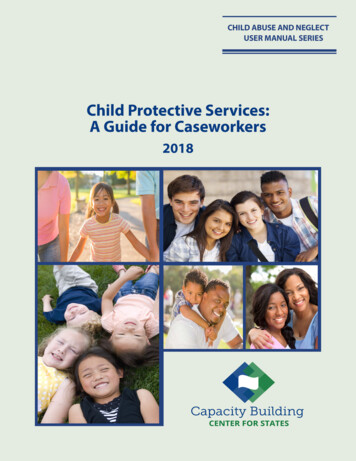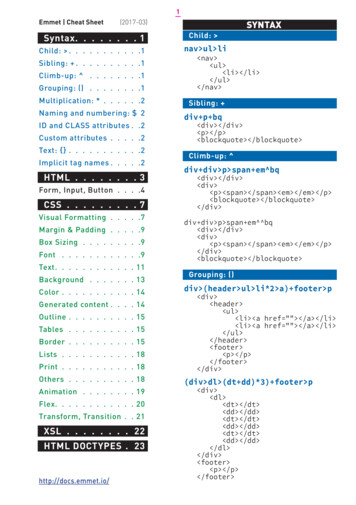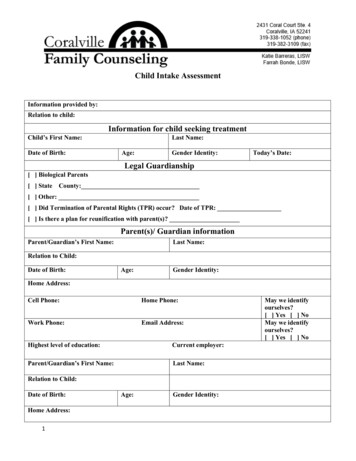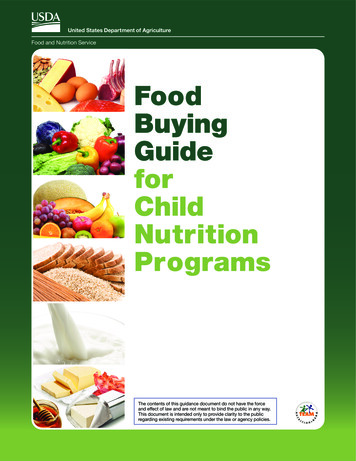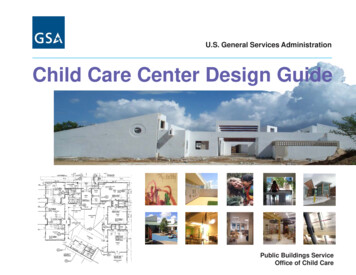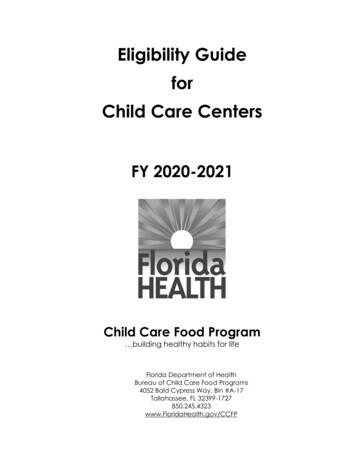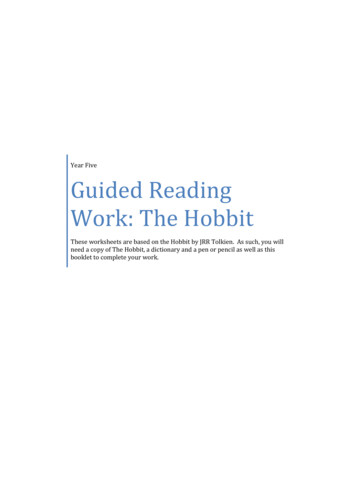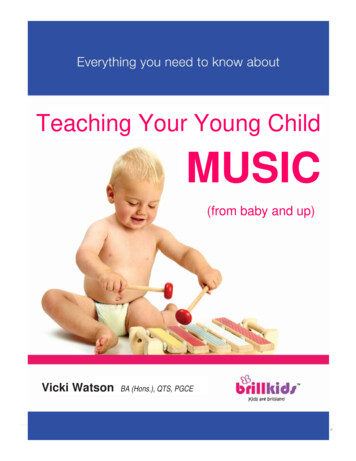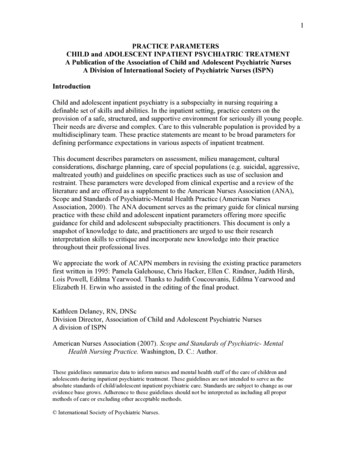
Transcription
CHILD ABUSE AND NEGLECTUSER MANUAL SERIESChild Protective Services:Child Protective Services: A Guide for CaseworkersA Guide forCaseworkersTo view or obtain copies of other manuals in this series, contact theNational Clearinghouse on Child Abuse and Neglect Information nch/pubs/usermanual.cfmU.S. Department of Health and Human ServicesAdministration for Children and FamiliesAdministration on Children, Youth and FamiliesChildren’s BureauOffice on Child Abuse and Neglect
Child Protective Services:A Guide for CaseworkersDiane DePanfilisMarsha K. Salus2003U.S. Department of Health and Human ServicesAdministration for Children and FamiliesAdministration on Children, Youth and FamiliesChildren’s BureauOffice on Child Abuse and Neglect
Table of ContentsPREFACE . 1ACKNOWLEDGMENTS . 31.PURPOSE AND OVERVIEW . 72.CHILD PROTECTIVE SERVICES THEORY AND PRACTICE. 9Philosophy of Child Protective Services.9Framework for Practice. 11Caseworker Competence . 113.THE HELPING RELATIONSHIP. 17Core Conditions of the Helping Relationship . 17Techniques for Building Rapport . 19Use of Authority in Child Protective Services . 204.RESPONSIBILITIES OF CHILD PROTECTIVE SERVICES . 25Intake . 25Initial Assessment or Investigation . 25Family Assessment. 26Case Planning. 26Service Provision . 26Family Progress . 27Case Closure . 275.INTAKE. 29Intake Process . 29Intake Information Analysis. 34Response Time. 36Importance of Community Education in Reporting . 38Child Protective Services: A Guide for Caseworkersii
6.INITIAL ASSESSMENT OR INVESTIGATION . 39Effective Initial Assessment or Investigation Characteristics . 40Initial Assessment or Investigation Decisions. 40Initial Assessment or Investigation Process . 50Interviewing Techniques . 58Community Involvement. 63Special Practice Issues . 657.FAMILY ASSESSMENT . 69Family Assessment Principles . 69Family Assessment Decisions . 70Family Assessment Process. 70Special Practice Issue—Cultural Sensitivity . 758.CASE PLANNING. 77Developing the Case Plan . 77Involving the Family. 78Targeting Outcomes. 79Determining Goals . 81Determining Tasks . 82Developing Concurrent Plans . 829.SERVICE PROVISION. 83Service Framework Based on Levels of Risk . 83Case Management. 85Treatment and Intervention . 8610.FAMILY PROGRESS. 95Collect and Organize Information on Family Progress . 95Analyze and Evaluate Family Progress. 9611.CASE CLOSURE. 99Types of Case Closure . 99Process of Case Closure . 100Community Collaboration During Case Closure. 100Family Involvement During Case Closure . 10012.EFFECTIVE DOCUMENTATION .101Purposes of Child Protective Services Record-keeping . 101Content of Case Records. 102Principles of Record-keeping . 103iiTable of Contents
13.SUPERVISION, CONSULTATION, AND SUPPORT.105Supervisory Involvement in Decision-making . 105Supervisory Involvement in Clinical Consultation . 106Peer Consultation . 107Supervisory Monitoring of Casework Practice . 108Caseworker Safety . 109Peer Support and Burnout Prevention . 109Conclusion. 110ENDNOTES .111APPENDICES:APPENDIX A—GLOSSARY OF TERMS .121APPENDIX B—RESOURCE LISTINGS OF SELECTED NATIONAL ORGANIZATIONSCONCERNED WITH CHILD MALTREATMENT .127APPENDIX C—STATE TOLL-FREE TELEPHONE NUMBERS FOR REPORTINGCHILD ABUSE .133APPENDIX D—NATIONAL ASSOCIATION OF SOCIAL WORKERS CODE OFETHICS.135Child Protective Services: A Guide for Caseworkersiii
PrefaceEach day, the safety and well-being of somechildren across the Nation are threatened bychild abuse and neglect. Intervening effectivelyin the lives of these children and their families isnot the sole responsibility of any single agency orprofessional group, but rather is a shared communityconcern.Since the late 1970s, the Child Abuse and NeglectUser Manual Series has provided guidance onchild protection to hundreds of thousands ofmultidisciplinary professionals and concernedcommunity members. The User Manual Seriesoffers a foundation for understanding childmaltreatment and the roles and responsibilities ofvarious practitioners in its prevention, identification,investigation, and treatment. Through the years,the manuals have served as valuable resources forbuilding knowledge, promoting effective practices,and enhancing community collaboration.Since the last update of the User Manual Series inthe early 1990s, a number of changes have occurredthat dramatically affect each community’s responseto child maltreatment. The changing landscapereflects increased recognition of the complexity ofissues facing children and families, new legislation,practice innovations, and systems reform efforts.Significant advances in research have helped shapenew directions for interventions, while ongoingevaluations help us to know “what works.”Child Protective Services: A Guide for Caseworkers1The Office on Child Abuse and Neglect (OCAN)within the Children’s Bureau of the Administrationfor Children and Families (ACF), U.S. Departmentof Health and Human Services (DHHS), hasdeveloped this third edition of the User ManualSeries to reflect our increased knowledge and theevolving state of practice on child protection. Theupdated and new manuals are comprehensive inscope while also succinct in presentation and easyto follow, and they address trends and concernsrelevant to today’s professional.This manual, Child Protective Services: A Guide forCaseworkers, examines the roles and responsibilitiesof child protective services (CPS) workers, whoare at the forefront of every community’s childprotection efforts. The manual describes the basicstages of the CPS process and the steps necessaryto accomplish each stage: intake, initial assessmentor investigation, family assessment, case planning,service provision, evaluation of family progress,and case closure. Best practices and critical issuesin casework practice are underscored throughout.The primary audience for this manual includesCPS caseworkers, supervisors, and administrators.State and local CPS agency trainers may use themanual for preservice or inservice training of CPScaseworkers, while schools of social work may addit to class reading lists to orient students to the fieldof child protection. In addition, other professionalsand concerned community members may consult1
the manual for a greater understanding of the childprotection process.This manual builds on the information presentedin A Coordinated Response to Child Abuse andNeglect: The Foundation for Practice. Readers areencouraged to begin with that manual as it addressesimportant information on which CPS practice isbased—including definitions of child maltreatment,risk factors, consequences, and the Federal and Statebasis for intervention. Some manuals in the seriesalso may be of interest in understanding the rolesof other professional groups in responding to childabuse and neglect, including: Substance abuse treatment providers Domestic violence victim advocates Educators Law enforcement personnel.Other manuals address special issues, such asbuilding partnerships and working with the courtson CPS cases.User Manual SeriesThis manual—along with the entire Child Abuse and Neglect User Manual Series—is available from theNational Clearinghouse on Child Abuse and Neglect Information. Contact the Clearinghouse for a fulllist of available manuals and ordering information:National Clearinghouse on Child Abuse and Neglect Information330 C Street, SWWashington, DC 20447Phone: (800) FYI-3366 or (703) 385-7565Fax: (703) 385-3206E-mail: nccanch@calib.comThe manuals also are available online at www.calib.com/nccanch/pubs/usermanual.cfm.2Preface
AcknowledgmentsAUTHORSDiane DePanfilis, Ph.D., M.S.W., is Associate Professorof Social Work at the University of Maryland,Baltimore, where she teaches social work practiceand child welfare research courses in the Master’sof Social Work program and research seminars inthe doctoral program. She is also codirector of theCenter for Families, an interdisciplinary partnershipbetween the schools of social work and medicine andthe department of pediatrics. Over the past 30 yearsshe has provided child welfare services at the locallevel as a caseworker, supervisor, and administrator;worked as a consultant at the national levelconducting program evaluations and providingtraining and technical assistance to social workersand other disciplines; and conducted extensivestudies related to the delivery of child protectiveservices and the prevention of child maltreatment.She is coeditor of the Handbook on Child ProtectionPractice and is a former president of the AmericanProfessional Society on the Abuse of Children.Marsha K. Salus, M.S.W., is a social work consultant.She has worked in the child welfare field for 27years. She began her career as a CPS worker andsupervisor. She has developed several nationalcurricula for child welfare workers and supervisors.She developed a number of preservice and inserviceChild Protective Services: A Guide for Caseworkers3training programs for child welfare workers andsupervisors in a variety of States. For example,Ms. Salus developed a 12-day core supervisorytraining program entitled “Mastering the Art ofChild Welfare Supervision,” which she has deliveredthroughout the country. In addition, she hasprovided training on all aspects of family violenceto multidisciplinary audiences around the country.Ms. Salus has assisted State and local CPS agencies inprogram development and program evaluation andhas worked with several States to establish standardsof practice for child welfare supervision.ACKNOWLEDGMENTOFPRIOR EDITIONSThis manual is an update of the 1992 publicationChild Protective Services: A Guide for Caseworkersby Diane DePanfilis and Marsha K. Salus. The firstedition of the manual was published in 1980 asChild Protection: Providing Ongoing Services byCynthia K. Ragan, Marsha K. Salus, and GretchenL. Schultze. Prior editions contained materialbased on Child Protective Services: A Guide forWorkers by James L. Jenkins, Marsha K. Salus, andGretchen L. Schultze, published in 1979. The priorwork informed and contributed significantly to thecontent of this publication.3
REVIEWERSBeverly HeydonOffice of LawHoward County, MDCathy OverbaghNational Clearinghouse on Child Abuse andNeglect InformationKathy PintoDepartment of Social ServicesHoward County, MDBarry SalovitzNational Resource Center on Child MaltreatmentSarah WebsterTexas Department of Protective and RegulatoryServices (retired)TECHNICAL ADVISORY PANELJodi HillConnecticut Department of Children and FamiliesHartford, CTRobert Ortega, Ph.D.University of Michigan School of Social WorkAnn Arbor, MINancy RawlingsKentucky Cabinet for Families and ChildrenFrankfort, KYBarry SalovitzChild Welfare Institute/National Resource Centeron Child MaltreatmentGlenmont, NYSarah WebsterTexas Department of Protective and RegulatoryServicesAustin, TXThe following were members of the January 2001Technical Advisory Panel for the User Manual Seriescontract. The organizations identified reflect eachmember’s affiliation at that time.Ron ZuskinUniversity of Maryland at BaltimoreSchool of Social WorkBaltimore, MDCarolyn AbdullahFRIENDS National Resource CenterWashington, DCThe following members subsequently were added tothe Technical Advisory Panel:Lien BraggAmerican Public Human Services AssociationWashington, DCSgt. Richard CageMontgomery County Police DepartmentWheaton, MDDiane DePanfilis, Ph.D.University of Maryland at BaltimoreSchool of Social WorkBaltimore, MD4Pauline GrantFlorida Department of Children and FamiliesJacksonville, FLWilliam R. (Reyn) Archer III, M.D.Hill and Knowlton, Inc.Washington, DCDouglas BesharovAmerican Enterprise InstituteWashington, DCDavid Popenoe, Ph.D.National Marriage ProjectPrinceton, NJAcknowledgments
Bob ScholleIndependent ConsultantPittsburgh, PABrad Wilcox, Ph.D.University of Virginia, Department of SociologyCharlottesville, VAOTHER ACKNOWLEDGMENTSThe third edition of the User Manual Series wasdeveloped under the guidance and direction of IreneBocella, Federal Task Order Officer, and CatherineNolan, Director, Office on Child Abuse and Neglect.Also providing input and review was Susan Orr,Associate Commissioner, Children’s Bureau.This manual was developed and produced by Caliber Associates, Fairfax, VA, under ContractNumber HHS-282-98-0025.Child Protective Services: A Guide for Caseworkers5
CHAPTER 1Purpose and OverviewChild protective services (CPS), a division withinState and local social services, is at the centerof every community’s child protection efforts. Inmost jurisdictions, CPS is the agency mandated bylaw to conduct an initial assessment or investigationof reports of child abuse and neglect. It also offersservices to families and children where maltreatmenthas occurred or is likely to occur.CPS does not work alone. Many communityprofessionals—including law enforcement officers,health care providers, mental health professionals,educators, legal and court system personnel, andsubstitute care providers—are involved in efforts toprevent, identify, investigate, and treat child abuseand neglect. In addition, community-based andfaith-based organizations, substance abuse treatmentfacilities, advocates for victims of domestic violence,extended family members, and concerned citizens,among others, also play important roles in supportingfamilies and keeping children safe from harm.Typically, CPS is the lead agency in coordinating theefforts of the various disciplines working to protectchildren and to educate the community about theproblems of child abuse and neglect.This manual, Child Protective Services: A Guidefor Caseworkers, provides the fundamentalinformation that CPS professionals must know toperform essential casework functions. The manualdescribes:Child Protective Services: A Guide for Caseworkers7 The philosophical basis on which CPS isfounded; The responsibilities of CPS and its roles andrelationships with other community agenciesand professionals; The nature of the “helping relationship” anduse of authority in working with children andfamilies; The purposes, key decisions, and practice issuesfor the following stages of the CPS process:— Intake— Initial assessment or investigation— Comprehensive family assessment— Planning— Service provision— Evaluation of family progress— Case closure The effective documentation of actions in caserecords and information systems; The strategies for casework supervision, training,consultation, and support.Appendices to this manual include a glossary,sample casework tools, and references to additionalpublications and organizations with information onchild protection.7
8Child abuse and neglect is a complex problem, andchild protection is a challenging responsibility. Nosingle publication can provide all the informationneeded to promote effective CPS practice, exploreall of the relevant issues, or reflect the multitude ofpolicy and practice variations in place across thecountry. This manual, however, provides a startingpoint and a solid foundation for casework practicethat should be augmented through training, otherprofessional development activities, and experience. What factors contribute to abuse and neglect? What are the consequences of abuse and neglect? What can be done to prevent abuse and neglect? Which laws and policies guide public interventionin child maltreatment? What does the child protection process looklike?CPS workers are encouraged to read A CoordinatedResponse to Child Abuse and Neglect: TheFoundation for Practice. That manual, the first inthe series, answers the following 10 questions: Who should be involved in child protection atthe community level? How can organizations work together to protectchildren? What are the philosophical tenets of childprotection? What is child maltreatment? What is the scope of the problem?This manual, the second in the series, recapitulatessome of the most important points of the firstmanual.Purpose and Overview
CHAPTER 2Child Protective ServicesTheory and PracticeThe basis for child protective services (CPS)is a concern for the care of children, whichis expressed through laws established in everyState. The legal authority and the mandates thatevolved from child abuse laws are described in ACoordinated Response to Child Abuse and Neglect:The Foundation for Practice. These laws do notspecify all that must be done to assist families andchildren, but they do provide a framework withinwhich action can be taken.This chapter further explores how CPS staff fulfill theirresponsibilities of protecting children at risk of childmaltreatment. It begins with an expanded discussionof the philosophical tenets of child protection thatare described in A Coordinated Response to ChildAbuse and Neglect: The Foundation for Practice. Thechapter continues with a discussion of the theoreticaland practical framework for CPS practice. Finally,there is an examination of the competencies requiredof CPS workers.PHILOSOPHYOFCHILD PROTECTIVE SERVICESThe basic philosophical tenets of CPS include thefollowing:A safe and permanent home and family is thebest place for children to grow up. Every childhas a right to adequate care and supervision and tobe free from abuse, neglect, and exploitation. It isChild Protective Services: A Guide for Caseworkers9the responsibility of parents to see that the physical,mental, emotional, educational, and medical needsof their children are adequately met. CPS shouldintervene only when parents request assistanceor fail, by their acts or omissions, to meet theirchildren’s basic needs and keep them safe.Most parents want to be good parents and,when adequately supported, they have thestrength and capacity to care for their childrenand keep them safe. Most children are best caredfor in their own family. Therefore, CPS focuses onbuilding family strengths and provides parents withthe assistance needed to keep their children safe sothat the family may stay together.Families who need assistance from CPS agenciesare diverse in terms of structure, culture, race,religion, economic status, beliefs, values,and lifestyles. CPS agencies and practitionersmust be responsive to and respectful of thesedifferences. Further, CPS caseworkers should buildon the strengths and protective factors withinfamilies and communities. They should advocatefor families and help families gain access to theservices they need. Often, securing access meanshelping families overcome barriers rooted inpoverty or discrimination, such as readily accessibletransportation to services.CPS agencies are held accountable for achievingoutcomes of child safety, permanence, and familywell-being. To achieve safety and permanence for9
children, CPS must engage families in identifyingand achieving family-level outcomes that reducethe risk of further maltreatment and ameliorate theeffects of maltreatment that has already occurred.CPS efforts are most likely to succeed whenclients are involved and actively participatein the process. Whatever a caseworker’s role, heor she must have the ability to develop helpingalliances with family members. CPS caseworkersneed to work in ways that encourage clients to fullyparticipate in assessment, case planning, and othercritical decisions in CPS intervention.When parents cannot or will not fulfill theirresponsibilities to protect their children, CPShas the right and obligation to intervenedirectly on the children’s behalf. Both laws andgood practice maintain that interventions should bedesigned to help parents protect their children andshould be as unobtrusive as possible. CPS mustmake reasonable efforts to develop safety plans tokeep children with their families whenever possible,although they may refer for juvenile or family courtintervention and placement when children cannotbe kept safely within their own homes. To readmore about the working relationship between CPSand the court system, please refer to the user manualon working with the courts.When children are placed in out-of-home carebecause their safety cannot be assured, CPSshould develop a permanency plan as soon aspossible. In most cases, the preferred permanencyplan is to reunify children with their families. Allchildren need continuity in their lives, so if the goalis family reunification, the plan should includefrequent visits between children and their familiesas well as other efforts to sustain the parent-childrelationship while children are in foster care. Inaddition, the CPS agency must immediatelywork with the family to change the behaviorsand conditions that led to the maltreatment andnecessitated placement in out-of-home care.To best protect a child’s overall well-being,agencies want to assure that children move topermanency as quickly as possible. Therefore,along with developing plans to support reunification,agencies should develop alternative plans forpermanence once a child enters the CPS system. Assoon as it has been determined that a child cannotPhilosophical Underpinnings of CPSAdditional sources of information on the philosophical underpinnings of CPS and other child welfareservice programs include:10 Pecora, P. J., Whittaker, J. K., Maluccio, A. N., Barth, R. P., & Plotnick, R. D. (2000). The child welfarechallenge (2nd ed.). New York, NY: Aldine de Gruyter. National Association of Public Child Welfare Administrators. (1999). Guidelines for a modelsystem of protective services for abused and neglected children and their families. Washington, DC:American Public Human Services Association. Child Welfare League of America. (1999). CWLA standards of excellence for services for abused andneglected child
Baltimore, where she teaches social work practice and child welfare research courses in the Master’s of Social Work program and research seminars in the doctoral program. She is also codirector of the Center for Families, an interdisciplinary partnership between the schools of social wor
